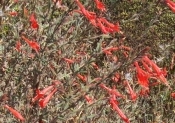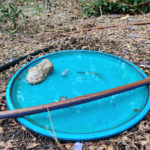Backyard Wildlife Habitats

Elements of Backyard Wildlife Habitats
1. Food
2. Water
3. Cover
4. Places to Raise Young
5. Sustainable Gardening
–from the National Wildlife Federation’s Backyard Wildlife Habitat Program
* Water * Cover * Open ground * Mulch * Nectar sources * Fruit * Seeds * Annual wildflower seed
— from Las Pilitas native plant nursery
Why Organic?
- Protect Future Generations
- Build Soil
- Protect Water Quality
- Save Energy
- Reduce Health Risk
- Promote Biodiversity
extract from Organic Times, Spring 1992,
Excerpted from an article by Sylvia Tawse.
… chemicals such as pesticides and herbicides, manufactured for killing, do not stop with the bugs and weeds shown on the box. They kill everything, from butterfly eggs to beneficial nitrogen-fixing bacteria. Please never use these horrible substances in your garden. At best a cruel hoax, they are more likely a devastating curse upon humanity.
–H.C. Flores, Food Not Lawns
On organic farms, there are
109 percent more wild plants
85 percent more plant species
32 percent more birds
5 percent more bird species
35 percent more bats
than on non-organic farms.
— study by the British Trust for Ornithology
The wildlife
Butterflies and Insects
- Bryant, Peter J, “Butterflies and Their Larval Foodstuffs.” Exceptional website with So. Calif. butterfly photos, larval photos and foodstuff plants, by a U.C.Irvine professor. Few other resources show as many instar stages for the larvae.
- Hogue, Charles L., Insects of the Los Angeles Basin (Natural History Museum of Los Angeles County, 1993) A comprehensive volume packed with both color and black & white photos, and descriptive text that tells habits and foraging.
- Natural History Museum of Los Angeles County, Butterfly Gardening in Southern California (ISBN 0-938644-35-1) This small pamphlet includes full color photos of the common butterflies and some of their larval stages. Text tells about lifecycles, seasonality, feeding habits, and host plants.
- Ryder, Joanne, Where Butterflies Grow (juvenile). Beautifully illustrated picture book, covering many of these adult-level topics.
- “Alternative Pollinators: Native Bees” an ATTRA article about attracting native bees, also known as solitary bees or pollen bees. (ATTRA = National Sustainable Agriculture Information Service)
- Squire, Ann O., Spiders of North America (juvenile). Highly recommended by my 10 y.o. book reviewer.
Birds and other critters
- Cornell Lab of Ornithology – join Project FeederWatch , or participate in the tenth annual Great Backyard Bird Count on February 16-19, 2007.
- eNature.com – an online “field guide” which can be sorted by zip code. Presented by the National Wildlife Federation.
- Fisher, Chris C. and Herbert Clarke, Birds of Los Angeles (incl. Santa Barbara, Ventura and Orange Counties)
- The Humane Society of the United States,Wild Neighbors: The Humane Approach to Living with Wildlife. Gives suggestions for dealing with squirrels, opossums and other animals which can become difficult in dense urban neighborhoods.
- Local Birds® of Orange County (many counties available) (Local Birds, Inc., 1996). A simple folding laminated card with illustrations of common backyard, trail, water and shore birds, excellent for quick reference or hiking.
- Morrison, Gordon, Nature in the Neighborhood (juvenile). Shows wildlife flourishing amidst an urban setting.
- National Audubon Society, First Field Guide to Birds (juvenile). Teaches how to look for birds, and what to look for. Because it is national, I recommend that it be used in conjunction with a full field guide such as Sibleys or Fisher so that you can actually find your local species.
- Sibley, David Allen, The Sibley Field Guide to Birds of Western North America.
The Habitat
- National Wildlife Federation’s Backyard Wildlife Habitat Program
- Mizejewski, David and the National Wildlife Federation, Attracting Birds, Butterflies and Other Backyard Wildlife. A richly-informative full-color guide to transforming your property.
- Natural History Museum of Los Angeles County, Butterfly Gardening in Southern California (ISBN 0-938644-35-1) This small pamphlet includes full color photos of the common butterflies and some of their larval stages. Text tells about lifecycles, seasonality, feeding habits, and host plants.
- The Xerces Society and the Smithsonian Institution, Butterfly Gardening: Creating Summer Magic in Your Garden.
Plant Selection
“Our native plants, having evolved here, are ideally suited to perform such ecological services as manufacturing oxygen and filtering impurities from our water. These plants also do the best job of providing food and shelter for native wild animals. Plants are a cornerstone of biological diversity. Biodiversity is vital to humans, because our survival depends on the earth and its life forms” — California Native Plant Society. (Read the full article)
“Sunset zones do not work very well with native plants. … The original zones were created to find the areas where fruit and vegetables would succeed. … Native plants care much more about rainfall, average 10 year winter low temperature, summer humidity and their plant community. Climate is better represented by plant communities, not Sunset Zones. So use your Sunset Western Garden Book to figure out the fruit tree you want, or if you can grow tomatoes, but use our plant community list for native plants.” — LasPilitas.com
Find your plant community by city name or zip code.
“Most of the population of California lives in the Coastal Sage Scrub plant community.” – LasPilitas.com
Read more about the Coastal Sage Scrub plant community. To open the list of the plants that are in the trade and live in California Coastal Sage Scrub click here.
About Native Plants
Our native plants, having evolved here, are ideally suited to perform such ecological services as manufacturing oxygen and filtering impurities from our water. These plants also do the best job of providing food and shelter for native wild animals. Plants are a cornerstone of biological diversity. Biodiversity is vital to humans, because our survival depends on the earth and its life forms. –from the California Native Plant Societywebsite
- Belzer, Thomas J., Roadside Plants of Southern California (Mountain Press, 1984) Excellent full color photos, a great “field guide” for taking on hikes.
- Bornstein, Carol et al, California Native Plants for the Garden. A welcome new addition to the Calif native plant bookshelf, this book includes color photos and encyclopedic-style notes about a considerable number of Calif native plants which are appropriate for garden cultivation. Includes some photos of well-designed native plant gardens.
- The California Native Plant Society, article “Why Grow Native Plants?” The California Native Plant Society has several local chapters throughout Southern California.
- Clarke, Charlotte Bringle, Edible and Useful Plants of California. Did you know that many California natives are edible? Learn which ones, and how to prepare them.
- Las Pilitas nursery’s online plant catalog is a wealth of information about Calif native plants
- McAuley, Milt, Wildflowers of the Santa Monica Mountains.
- PRBO Conservation Science, “Enhancing Coastal Scrub and Chaparral Habitat for Birds…” (pdf)
- Poyourow, Joanne, “Including Native Plants in Your Garden” article (pdf)
- Whitson, Tom, et al, Weeds of the West (Western Society of Weed Science, 9th Edition, 2001) Although it covers multiple states, this book includes grasses. Full color plates.
California Native Plant Sources
What is a native plant? Plants that grew here (in California) prior to European contact. They are the foundation of our native ecosystems, or natural communities. –paraphrased from the California Native Plant Society website
- Larner Seeds catalog and website, highly recommended for “Seeds of California Native Plants”
- Theodore Payne Foundation, Sun Valley. Browse and buy native plants at this local non-profit foundation.
- Las Pilitas – mail-order native plant nursery, with nursery sites in Escondido (San Diego county) and Santa Margarita (San Luis Obispo county).
Attracting Specific Critters
| Anise Swallowtail butterfly | Wild fennel** (Foeniculum vulgare), blossoms of the carrot family … Read more atLas Pilitas and Bryant |
| Buckeye butterfly | Snapdragons, Monkey flower* (Mimulus spp), Plantain** … Read more atLas Pilitas and Bryant |
| Monarch butterfly | Milkweed** (Asclepias spp) |
| Checkerspot butterflies | Tidy Tips* (Layia platyglossa) … Available at Larner Seed |
| Mourning Cloak butterfly | Elm, willow, birch, poplar, floss silk tree … Read more at Bryant |
| Painted Lady, West Coast Lady butterflies | Cheeseweed** (Malva parviflora), Lupines* … Read more at Las Pilitas and Bryant |
| Hummingbirds | Salvia spp, especially red and purple forms of Salvia gregii, Salvia elegans, Salvia leucantha, Salvia ‘Waverly’;Lobelia cardinalis*;Zauschneria* … For a list of Calif. native plants see Las Pilitas |
| Hoverflies (a group of essential pollinating insects) | Meadowfoam* (Limnanthes douglasii) … Available atLarner Seed |
* a California native plant
** plant often destroyed as a “weed”
Read about specific nectar and larval food plants in the Natural History Museum of Los Angeles County’s pamphlet “Butterfly Gardening in Southern California” (ISBN 0-938644-35-1). Also at Peter J Bryant’s website “Butterflies and Their Larval Foodstuffs.”
The Las Pilitas website offers a collection ofwildlife articles emphasising California native plants. The articles include designing the wildlife garden.
Sustainable Gardening
Sustainable gardening techniques include:
* Organic Gardening * Chemical-free * Insect Pest Management * Mulch * Compost (natural plant nutrition) * Preserving biodiversity * Functional landscaping (wildlife habitats and edible plants) * Restoring native plants * Xeriscape (drought-tolerant plants) * Removing invasive species * Harvesting rainwater (the path of the future) * Greywater (the path of the future) * Matching plant choices to micro-climate * Reducing lawn areas * Ecosystem management
- Hart, Rhonda Massingham, Bugs, Slugs and Other Thugs: Controlling Garden Pests Organically Accurate factual information presented with delightful humor.
- Hynes, Erin, Improving the Soil (Rodale’s Successful Organic Gardening series). Learn about the backbone element of sustainable gardening: your soil.
- Lavies, Bianca , Compost Critters (juvenile). Appreciate the richness of soil life with microscopic photos of the variety of critters (eew!) in a healthy compost pile.
Inspiration
- Rancho Santa Ana Botanic Garden, Claremont, CA. View an extensive collection of natives, arranged by plant community.
- Santa Barbara Botanic Garden, Santa Barbara, CA. Not exactly local, but a beautiful display of our California natives.
- Lowry, Judith Larner, Gardening with a Wild Heart. Delightfully written tales of transforming a property to a native plants landscape.
- Stein, Sara, Noah’s Garden and Planting Noah’s Garden. The latter includes both inspiration and how-to’s about planting a natural habitat-style garden.
- Shapiro, Howard-Yana, Gardening for the Future of the Earth. Explains how our environmental solutions all come together in the garden. Covers soil, water, biodiversity and more.


